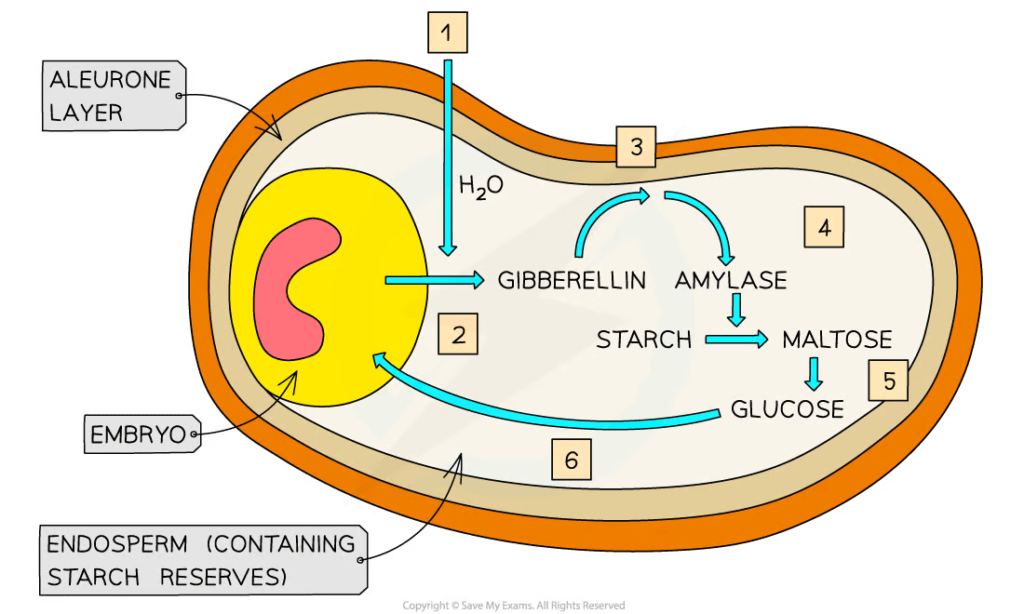Cytokinins
Cytokinins are plant hormones that regulate various physiological processes in plants, including cell division, differentiation, and growth. They have a number of practical applications in agriculture, forestry, and horticulture.
This group of hormones includes kinetin, benzyl amino purine, zeatin, and isopentenyl-adenine compounds ten times more powerful than kinetin and other natural or synthetic compounds with morpho-genetic roles used in tissue cultures. Cytokinins are derivatives of adenine. The functional activity of cytokinins occurs in the presence of auxins.

Biosynthesis
Zeatin is synthesized from mevalonic acid and adenine. It was found that cytokinins are the result of the degradation of nucleic acids and therefore, could serve as an indicator of the rate of DNA replication. In plants, cytokinins exist in free and bound forms. Bound cytokinins are synthesized in the cytoplasm and
chloroplasts.
It is assumed that they may be synthesized also in mitochondria based on their own DNA. This confirms the endosymbiotic theory of organelle genesis.
Transport
Very rich in cytokinins are green seeds, and meristematic tissues, but the main site of cytokinin synthesis is the apical meristem, especially the root (Fig. ), from where they have transported ascendantly (acropetal), passive with the flux of other metabolites.
Mechanism of action
Cytokinins may impact the structural and functional status of the cell. Acting artificially with a synthetic analogue of cytokinin the following effects were observed: cell rejuvenation and restoration of damaged structures, an increase in the size of the nucleus, chromatin structure becomes more diffuse, mRNA biosynthesis is enabled, more ribosomes are formed as well as new grana and lamellae in the chloroplasts stroma, more cristae in mitochondria.
All these changes demonstrate an increased functional activity of the cell by increasing the biosynthesis of RNA and protein, an increase in the amount of chlorophyll, and also an increase in the intensity of photosynthesis (Fig. ). Under cytokinin action activation of all types of RNA in cut leaves (mRNA, tRNA, rRNA) occurs.
Biological significance
Cytokinins exhibit the following physiological features:
• stimulate cell division and germination of the seeds
• determine bud and shoot formation from undifferentiated callus in cultures in vitro
• delay senescence, increasing photosynthesis and metabolic activity
• mobilize and attract metabolic substances and minerals to the dominant centers
• stimulate the exit from dormancy and neutralize apical dominance
• activate callogenesis as a result of active cell division
• activate differentiation of adventitious buds on stems and roots
• involved in apical dominance, stimulating seed germination, and inducing anthesis
• increase resistance to cold and toxic substances
• together with auxins, activate the formation of generative organs
• activate enzymatic systems (nitrate reductase, isocitrate lyase, protease, etc.
• enhances RNA polymerase and chromatin activity
• cytokinins increase the number of polyribosomes
• stimulate cell division and germination of seeds
• stimulates the synthesis of RNA, DNA, and proteins
• delay aging
• have a correlating action on lateral and apical buds.
Practical applications
One common use of cytokinins is in the production of plant tissue culture media. Cytokinins are often added to these media to promote the proliferation of plant cells and the formation of new plant tissues. This is useful for the production of plant clones, which are genetically identical copies of a parent plant. Clones are often used to mass-produce plants that have desirable traits, such as disease resistance or high yields.
Cytokinins are also used to promote the rooting of cuttings, which is a common method of propagating plants. By applying cytokinins to the cuttings, the cuttings are more likely to develop roots, allowing them to be transplanted into soil and grown into full-sized plants.
In addition to these applications, cytokinins are also used to improve the growth and development of plants in agricultural and horticultural settings. For example, cytokinins may be applied to plants to stimulate cell division and increase the size and yield of fruit crops. They may also be used to promote the growth of root systems in trees, which can improve their ability to withstand drought and other stressors.
Overall, cytokinins have a range of practical applications in plant cultivation and production, making them important tools for farmers, gardeners, and other plant professionals.
Cytokinins stimulate the opening of the buds, enhance leaves and cotyledon growth, have a revitalizing effect on aging leaves, and have an influence on nutrients. Also, they stimulate the rooting of the cuttings and cause the transition of a greater number of vegetative buds into floral buds.
